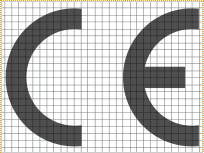CE Marking to EU Directives
 When designing the machine for the customers in Europe, I have to make sure that the machine has full CE compliance.
When designing the machine for the customers in Europe, I have to make sure that the machine has full CE compliance.By the way, what is CE?
I search for more details about CE and put them here for more understanding.
The CE marking is an acronym for the French "Conformité Européenne". By affixing the CE marking, the manufacturer, or in certain cases another legal person responsible for the product, asserts that the item meets all the essential "Health and Safety" requirements of the relevant European Directive(s) that provide for the CE marking. Examples of European Directives requiring CE marking include toy safety, machinery, low-voltage equipment, medical devices and electromagnetic compatibility.
CE Marking Procedure
The "New Approach" to conformity enables manufacturers to use what is called as "SELF DECLARATION" where the manufacturer himself declares conformity by signing the "Declaration of Conformity (DOC)" and then affixes the CE Mark on his product.
The following simple steps are involved
STEP 1: Identify Applicable "DIRECTIVES"
STEP2 : Identify Applicable "Conformity Assessment Module"
Although CE Marking follows the Self Declaration principle, depending upon product complexity and risk to human life, various conformity assesment module are prescribed:-
Module 'A' (Internal Production control).
Applicable for products falling under EMC and Low Voltage Directives. Manufacturer tests the product from third party. After compliance with the tests, his production process ensures continued conformance. He maintains "Technical Documentation" as a proof of compliance. There is No mandatory involvement of European Lab (i.e. Notified Body).
Module 'B' to 'H'
Mandatory involvement of European Lab is required which issues "Type Examination Certificate", certifies documentation (called "Techncal Construction File"(TCF) and carries out inspections.
STEP3 : Identify Applicable "Standard"
STEP4 : Test one sample of the productEither yourself or from test lab.
STEP5 : Compile "Technical Documentation"
STEP 6 : Sign the EC "Declaration of Conformity"
STEP 7 : Affix "CE Mark" on the product.
Source: http://en.wikipedia.org/wiki/CE_mark
There are 21 European "New Approach" Directives against which a wide range of products are required to be CE marked against before they are "placed on the market" in Europe. When placing the CE mark on the product the manufacturer or "his authorized representative in the European union" is declaring that the product complies with all applicable directives. The list of 21 applicable directives can be found on the European Commission website. The EU Directives are not themselves law as they are all taken into the the law of each member state. Whilst the directive and standards may be harmonized across Europe manufacturers still need to be aware of country specific requirements in safety standards, permitted frequency bands and other areas that might affect their product.
Some directives requirements are more onerous than others, but a general guide is that a manufacturer must
- identify all directives applicable to their product
- assess their product against the requirements of a directive - usually through a combination of technical argument and testing. Testing can be done in house by the manufacturer or by 3rd party specialist test laboratories
- create a Technical File containing full details of the product and all assessments carried out to demonstrate compliance. This technical file becomes a living document and needs to be kept up-to-date as changes occur to the product or to the standards against which the product was assessed
- depending on the directive there is an optional or mandatory requirement to have the Technical File assessed by a Notified Body
- Draw up and sign a Declaration of Conformity and affix CE mark to the product and/or packaging
Charlie is a CE marking consultant at DheaniSulis Ltd who specialise in helping companies navigate their way through these product approval requirements in a timely and cost efficient manner.
Article Source: http://EzineArticles.com/?expert=Charlie_Blackham




Comments